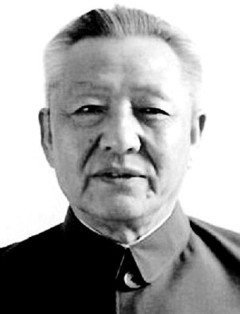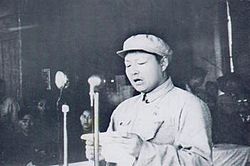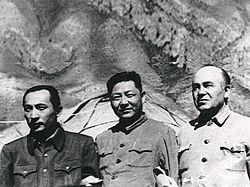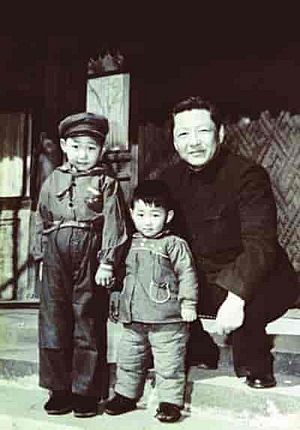Xi Zhongxun facts for kids
Quick facts for kids
Xi Zhongxun
|
|
|---|---|
|
习仲勋
|
|

Xi Zhongxun in the 1990s
|
|
| Vice-Chairman of the Standing Committee of the National People's Congress | |
| In office 10 September 1980 – 15 March 1993 |
|
| Chairman | Ye Jianying→Peng Zhen→Wan Li |
| 1st Secretary-General of the State Council | |
| In office September 1954 – January 1965 |
|
| Premier | Zhou Enlai |
| Preceded by | Li Weihan |
| Succeeded by | Zhou Rongxin |
| 14th Head of the Propaganda Department of the Central Committee of the Chinese Communist Party | |
| In office January 1953 – July 1954 |
|
| Party Chairman | Mao Zedong |
| Preceded by | Lu Dingyi |
| Succeeded by | Lu Dingyi |
| Personal details | |
| Born | 15 October 1913 Fuping County, Shaanxi, Republic of China |
| Died | 24 May 2002 (aged 88) Beijing, People's Republic of China |
| Political party | Chinese Communist Party (1928–1993) |
| Other political affiliations |
Kuomintang (1937–1945) |
| Spouses | Hao Mingzhu Qi Xin |
| Children | 7, including Qi Qiaoqiao, Xi Jinping and Xi Yuanping |
| Xi Zhongxun | |||||||||
|---|---|---|---|---|---|---|---|---|---|
| Simplified Chinese | 习仲勋 | ||||||||
| Traditional Chinese | 習仲勲 | ||||||||
|
|||||||||
Xi Zhongxun (born October 15, 1913 – died May 24, 2002) was an important Chinese leader. He was a Communist revolutionary and a government official. He helped shape China from the 1930s to the 1980s.
Xi Zhongxun was known for being fair and open-minded. He faced many challenges in his career. He was even put in prison several times. His second son, Xi Jinping, is the current leader of China.
Contents
Early Life and Joining the Party
Xi Zhongxun was born on October 15, 1913. His family owned land in Fuping County, Shaanxi province. In May 1926, he joined the Chinese Communist Youth League. This was a group for young people who supported the Communist Party.
In 1928, he took part in student protests. The government at the time, called the Kuomintang, put him in prison. While in prison, he officially joined the Chinese Communist Party (CCP).
His Career in China
Fighting for the Red Army
In 1930, the Communist Party asked Xi to work with a different army. In March 1932, he led a small uprising, but it was not successful. After that, he joined Communist fighters near the Wei River.
By 1933, he helped create a special area called the Shaanxi–Gansu Border Region Soviet Area. He became the leader of this area. He also led fighters against the Nationalist government. This area grew and became a very important base for the Communists.
In 1935, Xi was briefly jailed by some party members. But Mao Zedong, the top Communist leader, ordered his release. Xi's base became a safe place for Mao and his followers after their long journey, known as the Long March. This base later became the Yan'an Soviet, the main headquarters for the Communist movement until 1947.
During the Sino-Japanese War
During the Second Sino-Japanese War, Xi stayed in the Yan'an Soviet. He helped manage daily life and military needs. He worked to improve the economy in the area. He was known for making decisions based on facts. He also tried to avoid extreme ways of carrying out party rules.
In August 1945, he became an important member of the party's Central Committee. He also helped make decisions about who would work in different party jobs.
Chinese Civil War and New China
When the civil war started in 1947, Xi stayed in northwest China. He helped protect and later take back the Yan'an Soviet Area. He worked with commander Peng Dehuai to win battles and take control of northwest China.
Xi was in charge of bringing Communist rule to these new areas. He was known for using calm methods. He often tried to solve problems without fighting.
Xi sometimes disagreed with the land reform movement. This movement took land from rich landowners and gave it to poor farmers. Xi believed in protecting the rights of middle-class farmers. In 1952, he stopped some extreme actions in Xinjiang. He argued against taking animals from herders and land from religious leaders. These actions had caused problems. With Mao's support, Xi changed these policies. He released many herders from prison.
In 1951, some groups in Qinghai rebelled. Xi Zhongxun pushed for a peaceful solution. He sent people to talk with the rebel leaders. He offered good terms and forgave those who had rebelled. One leader, Xiang Qian, eventually returned and joined the new government. Mao Zedong praised Xi for his smart way of handling this situation.
In 1954, the 14th Dalai Lama visited Beijing. Xi spent time with him. The Dalai Lama remembered Xi as "very friendly" and "open-minded." He even gave Xi an Omega watch as a gift. Years later, Xi was still wearing that watch.
High Positions in Beijing and Challenges
In September 1952, Xi Zhongxun became the head of the party's propaganda department. He was in charge of culture and education. In 1956, he became a member of the CCP Central Committee. In 1959, he became a vice-premier. He worked with Premier Zhou Enlai on making laws and policies.
In 1962, he faced serious accusations. He was removed from all his leadership roles. This happened because he supported a book about his old friend, Liu Zhidan. Some people claimed the book was secretly trying to help another leader who had been removed from power. Xi was forced to admit mistakes. In 1965, he was sent to work in a tractor factory.
During the Cultural Revolution, a difficult time in China, Xi was treated very badly. He was put in prison and kept in isolation for a long time. He finally gained his freedom in May 1975. He was then sent to another factory.
Leading Guangdong Province
After the Cultural Revolution ended, Xi was fully cleared of all accusations in 1978. From 1978 to 1981, he held important leadership roles in Guangdong Province. He was the provincial secretary and governor.
When he arrived in Guangdong, many people were trying to leave China for Hong Kong. Wages in Guangdong were very low compared to Hong Kong. Xi understood why people wanted to leave. He believed that Guangdong needed to open its economy.

In 1979, he convinced Deng Xiaoping, another top leader, to let Guangdong make its own trade decisions. He also suggested creating special areas to attract foreign money. Deng Xiaoping agreed. He called these areas "special zones." He told Xi that the government had no money but could give Guangdong special policies. Deng told Xi, "You have to find a way, to fight a bloody path out." Xi then proposed creating the first four special economic zones. These zones helped Guangdong's economy grow very fast.
Retirement
In 1981, Xi returned to Beijing. He became a deputy chair of the Standing Committee of the National People's Congress. He helped write many new laws. In 1982, he became a member of the CCP Politburo.
In 1987, some powerful leaders wanted Hu Yaobang to resign as the party's General Secretary. Xi was the only one who spoke up to defend Hu. Xi retired from public service in April 1988. He spent most of his retirement years in Shenzhen, a city he helped develop.
Family and Legacy
Xi Zhongxun had two wives. In 1936, he married Hao Mingzhu. They had three children: Xi Fuping, Xi Heping, and Xi Ganping. Xi Heping sadly died during the Cultural Revolution. Xi Fuping worked in the Ministry of Defence and later in government. He passed away in 1998.
In 1944, Xi Zhongxun married Qi Xin. They had four children: Qi Qiaoqiao, Xi An'an, Xi Jinping, and Xi Yuanping. His son, Xi Jinping, became the leader of China in 2012.
Xi Zhongxun died on May 24, 2002. His funeral was attended by many important leaders. He was buried in a cemetery named after him in Fuping County. His official obituary called him "an outstanding revolutionary" and "a great communist soldier." He was remembered as one of the main founders of the revolutionary base areas in the Shaanxi-Gansu border region.
Images for kids
-
Shenzhen, pictured here, grew into one of China's largest cities after it became a special economic zone.
See also
 In Spanish: Xi Zhongxun para niños
In Spanish: Xi Zhongxun para niños











